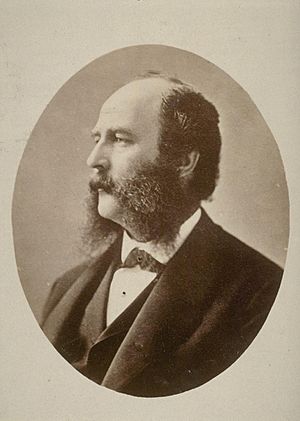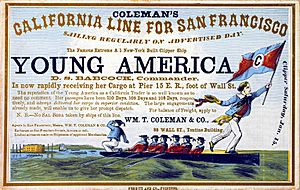William Tell Coleman facts for kids
William Tell Coleman (1824–1893) was an American pioneer who helped settle California. He was known for his leadership in citizen groups that tried to keep order in early San Francisco. He also made a name for himself in shipping and borax mining.
Contents
Early Life
William Tell Coleman was born on February 29, 1824, in Cynthiana, Harrison County, Kentucky. He went to school at St. Louis University in Missouri.
Keeping Order in San Francisco
In 1849, Coleman arrived in California and settled in San Francisco. He started a business in shipping. He became a leader in groups called the Committees of Vigilance. These were groups of citizens who took action when they felt the government wasn't doing enough to control crime.
Coleman led a large Committee of Vigilance in 1856. This group worked to bring order to the city. After their work, the Committee of Vigilance ended. They helped create a new political group called the People's Party. This party later joined with the Republican Party. It controlled San Francisco's government until 1867.
Shipping Business
In 1856, Coleman started a shipping line that connected New York City and San Francisco. He moved to New York in 1857 to run his business from there until 1864.
Coleman also helped develop the town of San Rafael, California. He made it a more beautiful and bigger place.
The Pick Handle Brigade
In 1877, a protest in San Francisco turned into a riot against Asian people. Coleman again helped organize a group to stop the unrest. This new group was called the Committee of Safety. It worked with the city police to help keep the peace.
The Committee of Safety members were not given guns. Instead, they carried pick handles. Because of this, they became known as the "Pick Handle Brigade." Coleman was worried about the violence and wanted to prevent a working-class political party from gaining too much power.
Even though Coleman's main concern wasn't protecting the Chinese community, his actions helped calm the riots. However, a new political party called the Workingman's Party was formed. Its slogan was "The Chinese Must Go!" This party helped lead to the Chinese Exclusion Act of 1882. This law stopped Chinese workers from coming to the United States.
Borax Mining
In the 1880s, Coleman owned the Harmony Borax Works in Death Valley. This company used famous twenty mule teams to carry borax from 1883 to 1889. Borax is a mineral used in cleaning products and other things.
Coleman named a town called Lila C, California after his daughter, Lila C. Coleman. He lost a lot of money when the cost of importing borax changed. He filed for bankruptcy in 1888.
Death
William Tell Coleman died at his home in San Francisco on November 22, 1893.
Legacy
The mineral Colemanite was named in his honor.
An actor named Gregg Palmer played William Tell Coleman in a 1958 TV show episode. The show was called Death Valley Days. In the story, Coleman focused on farming and mining borax instead of gambling or looking for gold.
See also
- Twenty-Mule-Team Borax
- Francis Marion Smith
 This article incorporates text from a publication now in the public domain: "article name needed". New International Encyclopedia. (1905).
This article incorporates text from a publication now in the public domain: "article name needed". New International Encyclopedia. (1905).





